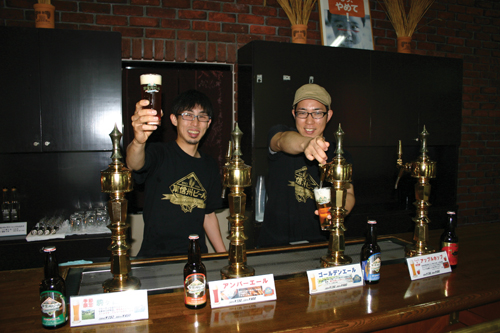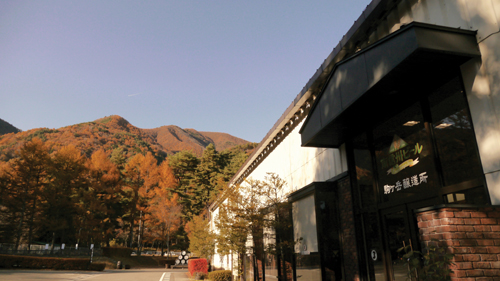by Kumagai Jinya

Mount Fuji recently became a registered World Heritage site and since the climbing trail opened in July, it has been absolutely packed every day with travelers. Mount Takao on the far outskirts of western Tokyo is famous for its crowded climbing path and it doesn’t appear as if its popularity is going to abate anytime soon. And in Nagano Prefecture, which offers key climbing experiences for enthusiasts anywhere from elementary school kids to adults, there is one mountain that is particularly popular: Kisokomagatake. During peak traffic times, the ropeway there becomes so crowded that they hand out numbers. Look instead to the foot of this mountain where you’ll find Minamishinshu Beer. As its name suggests, the brewery lies in the southern region of Nagano, in a town called Miyada. The restaurant it operates is in nearby Komagane City.
Honbôshuzô, known for developing the Mars Whisky brand, opened a whisky brewery in this city in 1985. Following liberalization of the brewing laws in 1994, Komagane and Miyada officials took an interest in brewing some local beer and visited their neighborhood whisky brewery to research the possibilities. Then in 1995, Komagane, Miyada and several private-sector local businesses established a public-private joint venture, with Honbôshuzô becoming the majority shareholder. The corporation received its brewing license on July 1st, 1996, opened its restaurant Ajiwai Kôbô (“flavor studio”) and started their operations. At the time, staff from Honbôshuzô handled brewing and the initial line-up included a golden ale, an amber ale, a dunkel weizen and a pilsner.
The individual who designed the recipes for this lineup and also provided the brewing technical support was none other than brewery consultant Ed Tringali. As noted in our other article, he also helped OH! LA! HO! and Swan Lake. The staff that benefitted from Tringali’s instruction included two members from Honbôshuzô and one other, Takehira Kôki, who had been working at the restaurant. During one episode at the plant when there was trouble with the keg cleaner, Takehira was able to help with the repair. He had previously worked in production control for a manufacturer and was rather good at equipment tinkering. The company learned of this ability and said, “Take care of the brewing,” thus switching his role. This same Takehira is also the godfather of the brewery’s wonderful Apple Hop fruit beer, mentioned later. He’s now the corporate director. The brewery staff also includes young brew master Ito Haruhiro and his assistant Niwa Takashi.
Having opened on July 1st they were in the middle of summer and the restaurant was booming. They increased sales again the next month, but things slowed in September and again in October. This wasn’t just because the high season for beer had passed, Takehira thought. “We had to do something else.” He decided to start bottling and selling beer that had for the most part only been available at the restaurant. For a mere ¥10,000 Takehira bought the parts for a bottle machine and assembled it himself. Bottles were primarily to satisfy demand for omiyage (souvenir gifts), but even then their beer production declined and a less-than-favorable financial situation progressed for years.
The current brew master, Ito, was a graduate of an agricultural high school and joined the company in 2000, before things had really gotten better. Ito had wanted to work in a business where he could make food or something similar and thought he would be joining the restaurant division, but was suddenly told the day before he joined the company that he was being transferred to brewery operations. Ito recalls, “I was shocked, of course, but thought that if I could learn to make something I knew nothing about then I had certainly landed an interesting job.”
His work began in April with bottling and keg cleaning. But summer is of course the peak time for beer so the company placed him square in the middle of preparations for that rush; they had him brewing by the following month.
“I didn’t really alter Ed’s recipes much. Of course, I tweaked them a little. I didn’t improve them, per se; I just refined them for our needs,” says Ito.
Takehira and Ito considered ways to improve their bottom line and decided that they should appeal directly to the consumer. They then began participating actively in events and served at their first BeerFes in 2008. Before the event, they didn’t have much of a national presence at all, but were confident that they had beer of that quality. The truth is that they were highly regarded by their peers.
“Among our fans there were probably some who thought, ‘This is a prized beer nobody but me knows about.’ Then we started pouring at events and some of those people sighed jokingly, ‘Ah, so now you’ve ventured out,’” laughs Takehira. As their involvement in events grew, so did their sales.
When 2008 swung around, Niwa, a native of Komagane, joined the brewery. After graduating from the Tokyo University of Agriculture, known for its department that covers brewing studies, Niwa worked in wholesale business for food products, but then made an abrupt U-turn. He joined the brewery in June and was told, “If you’re really a graduate of Nôdai, then why don’t you develop some new products for us?”
“But I hadn’t focused on brewing,” Niwa explained. “I had studied in university to become a managerial dietician. Since they were low on staff, though, and since they were about to launch into the busy summer season and would be working like animals, I helped them out.”
It wasn’t as if he started from absolute zero, however; it was his mission to realize the ideas that Takehira was already shaping. Since Niwa had come on board, Takehira was able to concentrate on getting the happoshu (beer with additives) license necessary for making some of the new beers he envisioned. Niwa’s endeavors in development progressed and reached fruition in 2009. This was the birth of Minamishinshu’s “Apple Hop” happoshu-beer, which is now widely admired by craft beer drinkers.
In 2010 they participated in BeerFes Tokyo 2012 and shined, winning the Tokyo Governor’s Award which is determined by audience voting. The beer is slightly dark in color and brewed with a weizen yeast, and as the name suggests, has a strong apple profile. With a slightly high ABV at 6.5%, it’s one serious beer. There are also variations to the brew depending on what kind of apples they use, and those subtle changes are a point of interest, too. All of the apples they use are the edible variety which is why with each brew they name them Kôgyoku or Shinano Sweet, for example, after the apple itself.
Takehira reminisces, “We really wanted local ingredients. We originally tried to go that route with malt but weren’t successful. We settled down when we went with locally grown apples. From the beginning it would have been easier to simply use apple juice in the brewing, but that would have violated our goal of using local apples. Additionally we want our Apple Hop to spark interest in the many varieties of apples.”
“Creating a craft beer that both gives back to the local community and encourages people to seek new kinds of food is, for me, a job like no other,” Niwa adds, deepening the impression of how worthwhile his pursuit is.
If you are going to visit Minamishinshu Beer’s restaurant, the summer season is good. People who aren’t from Nagano prefecture perhaps can’t quite place where Komagane is, but it’s accessible by railway, and buses from Tokyo, Nagoya, Osaka and Kyoto all depart for it. Take the opportunity to experience both green mountains and a beer made from the region’s apples that is popular all over Japan. You won’t be disappointed.

This article was published in Japan Beer Times # () and is among the limited content available online. Order your copy through our online shop or download the digital version from the iTunes store to access the full contents of this issue.



